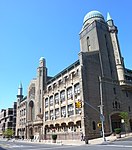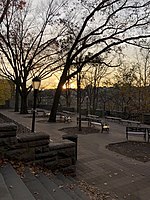191st Street station

The 191st Street station is a station on the IRT Broadway–Seventh Avenue Line of the New York City Subway. Located at the intersection of St. Nicholas Avenue and 191st Street in the Washington Heights section of Manhattan, it is served by the 1 train at all times. It is the deepest station in the New York City Subway system at about 173 feet (53 m) below street level. Access to the station's main entrance is only provided by four elevators from the mezzanine situated above the platforms. A 1,000-foot-long (300 m) pedestrian tunnel also extends west from the station to Broadway, connecting it with the Fort George neighborhood. Built by the Interborough Rapid Transit Company (IRT), the station opened on January 14, 1911, as an infill station along the first subway. Even though the line through the area had opened five years earlier, no station was constructed at this location because the surrounding neighborhood had a lower population than other areas of Manhattan. Before the opening of the pedestrian tunnel two years later, the area's hilly topography made it hard for area residents to access the station. The opening of the station and the tunnel led to the development of the surrounding area, including the construction of apartment buildings. Hundreds of lots held by the Bennett family since 1835 were sold at an auction in 1919. These provided additional housing opportunities for the middle class, taking advantage of the area's improved transportation access.
Excerpt from the Wikipedia article 191st Street station (License: CC BY-SA 3.0, Authors, Images).191st Street station
West 191st Street, New York Manhattan
Geographical coordinates (GPS) Address Nearby Places Show on map
Geographical coordinates (GPS)
| Latitude | Longitude |
|---|---|
| N 40.855 ° | E -73.929 ° |
Address
West 191st Street 570
10040 New York, Manhattan
New York, United States
Open on Google Maps







